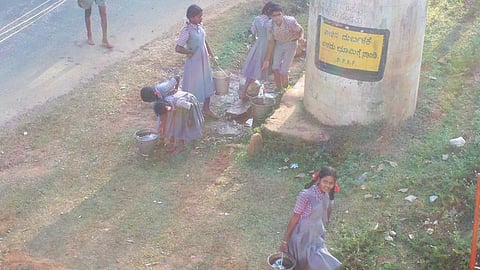
- Topics
- Feature
- Opportunities & Events
- About
- Hindi Portal
- Data
- Topics
- Feature
- Opportunities & Events
- About
- Hindi Portal
- Data

Tap water supply to government schools and anganwadis in a grim state: Panel report
According to information provided to the Parliamentary Standing Committee on Water Resources, only half of government schools and anganwadis have tap water supply, despite a 100-day campaign for 100 percent coverage being launched by the Jal Shakti Ministry in October 2020. The 100-day period ended on January 10, 2021. However, as of February 15th, only 48.5 percent of anganwadis and 53.3 percent of schools had tap water supply, the panel was told.
While the seven states-- Andhra Pradesh, Goa, Haryana, Himachal Pradesh, Tamil Nadu, Telangana and Punjab-- achieved 100 percent coverage of tap water supply, Uttar Pradesh, West Bengal and Jharkhand achieved least coverage.
(The Hindu)
Odisha tops in number of contaminated sites: CPCB data
According to the Central Pollution Control Board (CPCB) data, of the 112 sites in the country contaminated by toxic and hazardous substances, 23 were in Odisha followed by Uttar Pradesh (21) and Delhi (11). As per the environment ministry, ‘contaminated sites’ are delineated areas in which “constituents and characteristics of the toxic and hazardous substances, caused by humans, exist at levels and in conditions which pose existing or imminent threats to human health and the environment”. These include production areas, landfills, dumps, waste storage and treatment sites, mine tailing sites, spill sites, chemical waste handler and storage sites. On the directions of the National Green Tribunal, remediation work has been started in 14 contaminated sites across seven states. (Down to Earth, Hindustan Times)
Few states execute micro irrigation systems: Govt report
27 States (including UTs) in India have less than 30 percent micro-irrigation systems out of which 23 have less than 15 percent micro-irrigation. The data from 2005-06 to 2020-21 shows that out of the total irrigated land in the country, only 19 percent is under micro-irrigation. Sikkim, Andhra Pradesh, Karnataka and Maharashtra have more than half of the net cultivated farmlands under micro-irrigation. However, Uttar Pradesh, the largest sugarcane grower, has only 1.5 percent while Punjab, the major wheat grower, has 1.2 percent land under micro-irrigation. Overall, the data shows that very few states have shown enthusiasm to execute micro irrigation systems to save water and add to the farmers’ income. (The Hindu Business Line)
Seven hydel projects in the Himalayan region vulnerable to damage from disasters
In its advisory dated February 11, RMSI, a global disaster risk management firm, said that apart from the two hydropower projects that were damaged in the recent flash floods, many other hydropower projects are vulnerable to natural disasters caused by floods, cloud bursts, Glacial Lake Outburst Floods (GLOFs), avalanches, landslides, and rockslides, in the Himalayan region.
The projects listed are Lata Tapovan (171 MW) on Dhauli Ganga; Vishnuprayag (400 MW) on Alaknanda; Tehri (1000 MW) on Bhagirathi; Vishnugad Pipalkoti (444 MW) on Alaknanda; Naitwari-Mori (60 MW) on Tons; Phata Byung (76 MW) on Mandakini and Singoli Bhatwari (99 MW) also on Mandakini. The analysis is based on machine learning-based models for landslides and avalanches and hydrodynamic models for floods and GLOFs to do a quick review of the hydropower projects in Uttarakhand. (Hindustan Times)
Ganga saviour begins fast unto death to save the river
27-year-old Brahmachari Atmbodhananda from Matri Sadan of Haridwar began his fast on February 23 to save the Ganga river from illegal mining, dam construction and pollution.
The computer science graduate from Kerala stopped consuming water on March 7 and demanded the cancellation of all hydropower projects on Ganga, Mandakini, Pindar, Bhagirathi, Alaknanda and Dhauliganga rivers. His other demands include stopping mining and stone crushing in Ganga river, constitution of Ganga Bhakt Parishad and high-level probe into the death of Ganga activist Swami Gyan Swarup Sanand. (The New Indian Express)
This is a roundup of important news published from March 1 - 15, 2021. Also read policy matters this week.